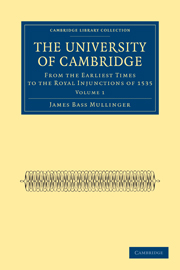Book contents
- Frontmatter
- PREFACE
- Contents
- CHAP. I FROM THE ROYAL INJUNCTIONS OF 1535 TO THE FOUNDATION OF TRINITY COLLEGE
- CHAP. II FROM THE FOUNDATION OF TRINITY COLLEGE TO THE ACCESSION OF ELIZABETH
- CHAP. III FROM THE ACCESSION OF ELIZABETH TO THE DEATH OF ARCHBISHOP PARKER
- CHAP. IV FROM THE DEATH OF ARCHBISHOP PARKER TO THAT OF LORD BURGHLEY
- CHAP. V COLLEGE LIFE
- CHAP. VI FROM THE DEATH OF LORD BURGHLEY TO THE ACCESSION OF CHARLES I
- APPENDIX
- INDEX
CHAP. V - COLLEGE LIFE
Published online by Cambridge University Press: 05 November 2011
- Frontmatter
- PREFACE
- Contents
- CHAP. I FROM THE ROYAL INJUNCTIONS OF 1535 TO THE FOUNDATION OF TRINITY COLLEGE
- CHAP. II FROM THE FOUNDATION OF TRINITY COLLEGE TO THE ACCESSION OF ELIZABETH
- CHAP. III FROM THE ACCESSION OF ELIZABETH TO THE DEATH OF ARCHBISHOP PARKER
- CHAP. IV FROM THE DEATH OF ARCHBISHOP PARKER TO THAT OF LORD BURGHLEY
- CHAP. V COLLEGE LIFE
- CHAP. VI FROM THE DEATH OF LORD BURGHLEY TO THE ACCESSION OF CHARLES I
- APPENDIX
- INDEX
Summary
Giles Fletcher of King's: b. 1548. d. 1610
Among the members of the university in the latter half of the sixteenth century, Giles Fletcher, the father of the poets, Giles and Phineas, filled a distinguished place. He had received his early education at Eton and from thence passed on to King's College, where he was elected to a fellowship in 1568. He appears to have continued to reside at the university some twelve years longer, and his attainments as a Latin scholar may be inferred from the fact that in the year 1577 he acted as deputy orator. His career as a diplomatist, and his notable mission to Russia, of which he left so interesting a record, together with his projects in the province of history which might have forestalled the labours of Camden, are matters beyond the scope of these pages. Sometime between the years 1595 and 1599, however, Fletcher would seem to have revisited Cambridge, and to have composed on that occasion his poem de Litteris antiquae Britanniae, in which he enumerates the fourteen existing colleges and briefly describes their external characteristics. His descriptions add but little to our knowledge of the Cambridge of his day. We learn, indeed, how the then modest structures of St Catherine's and Clare appeared dwarfed in their proximity to the ‘lofty walls’ of King's; that the new buildings recently added to Caius by its second founder considerably enhanced its appearance; that the horns of the antelope over the portals of St John's were gilded and the arms tinctured; and that Trinity, with its extensive precincts and majestic towers, was already almost what Giles Fletcher the younger affirmed it to be after Dr Neville's improvements, ‘the fairest sight in Cambridge.’
- Type
- Chapter
- Information
- The University of Cambridge , pp. 372 - 439Publisher: Cambridge University PressPrint publication year: 2009First published in: 1873

